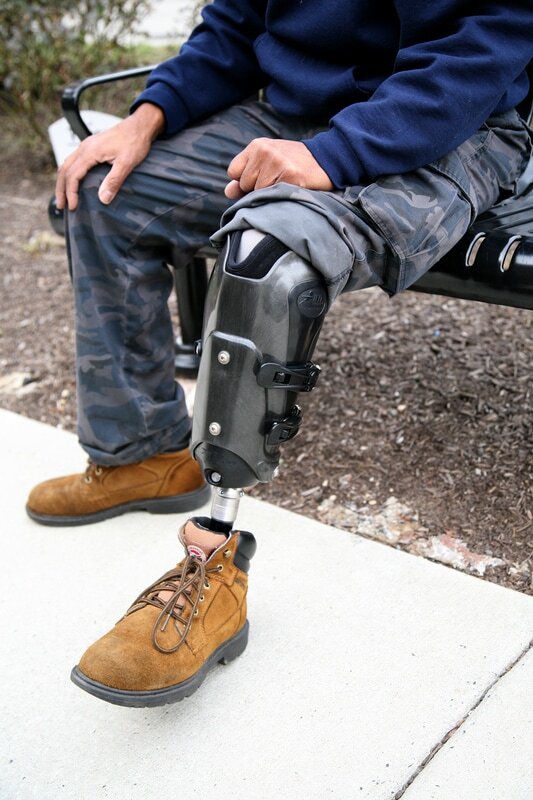In the realm of prosthetics, the transfemoral socket plays a pivotal role as the crucial interface between an individual's residual limb and the prosthetic device. This article delves into the significance of the transfemoral socket, its role in providing stability, and how advancements in prosthetic design contribute to enhancing overall functionality and comfort for those with above-the-knee amputations.
Understanding the Transfemoral Socket:
Bridging the Gap for Seamless Mobility:
The transfemoral socket is the component of a prosthetic limb designed to envelop and interface with the residual limb of individuals who have undergone above-the-knee amputations. This integral piece is custom-designed to ensure a secure fit, weight distribution, and overall stability during various activities.
Customization for Optimal Fit:
Just as with transtibial sockets, customization is key when it comes to transfemoral sockets. Prosthetists work closely with individuals to create sockets tailored to the unique contours, size, and condition of the residual limb. This personalized approach is fundamental for achieving optimal comfort and functionality.
Types of Transfemoral Sockets:
Ischial Containment Socket (ICS):
The ICS design focuses on containing and supporting the ischial tuberosity, enhancing stability and weight distribution. It is a popular choice for many transfemoral prosthetic users.
Quadrilateral Socket:
The quadrilateral socket design aims to distribute weight across the entire residual limb. It provides a balance between stability and comfort, catering to individuals with various activity levels.
Hybrid Sockets:
Hybrid sockets combine features from different designs, offering a customized solution that addresses specific anatomical and functional requirements.
The Crucial Role of the Transfemoral Socket in Stability:
Enabling Confident and Natural Movement:
Weight-Bearing Distribution:
One of the primary functions of the transfemoral socket is to evenly distribute the user's weight across the residual limb. This weight distribution minimizes pressure points, discomfort, and potential skin issues, contributing significantly to enhanced stability during weight-bearing activities.
Enhanced Suspension and Fit:
A well-designed transfemoral socket ensures secure suspension, preventing any unwanted movement or rotation of the prosthetic limb. Proper suspension is crucial for stability, allowing individuals to confidently engage in various activities, from walking and standing to more dynamic movements.
Control of Residual Limb Movement:
Similar to transtibial sockets, transfemoral sockets play a crucial role in controlling residual limb movement within the prosthetic device. This control is essential for achieving a natural gait and maintaining stability, especially during transitions such as weight shifts and changes in terrain.
Advancements in Transfemoral Socket Design:
Innovations Shaping Prosthetic Comfort:
Computer-Aided Design (CAD) and Manufacturing (CAM):
Advancements in computer-aided design and manufacturing have revolutionized transfemoral socket design. Prosthetists utilize sophisticated software and 3D scanning techniques to create highly precise sockets that align with the individual's unique anatomy. This technology contributes to improved comfort and stability.
Socket Liners with Advanced Materials:
Modern transfemoral socket liners incorporate advanced materials, such as silicone and thermoplastics. These materials offer benefits like improved shock absorption, reduced friction, and enhanced durability. The use of these materials contributes to a more comfortable and stable prosthetic experience.
Adjustable Socket Features:
Some transfemoral sockets come with adjustable features, allowing for real-time modifications to address changes in residual limb volume or comfort. Adjustable sockets provide users with a level of control over their prosthetic fit, contributing to enhanced overall stability.
Maintenance and Care of Transfemoral Sockets:
Preserving Longevity and Performance:
Regular Assessments:
Individuals using transfemoral prosthetics should undergo regular assessments with their prosthetist. These assessments involve evaluating the fit of the socket, addressing any comfort issues, and making necessary adjustments to maintain stability.
Skin Care and Hygiene:
Proper skin care around the residual limb is crucial for preventing skin-related complications. Keeping the skin clean, moisturized, and inspecting for any signs of irritation helps preserve the health of the skin and ensures a secure fit within the socket.
Monitoring Socket Integrity:
Regularly checking the integrity of the socket, including inspecting for any cracks, wear, or structural issues, is essential. Promptly addressing any signs of socket wear helps maintain stability and prevents potential malfunctions.
Conclusion:
The transfemoral socket serves as the cornerstone for stability in above-the-knee prosthetics, influencing the overall comfort and functionality of the prosthetic limb. As technology continues to advance, individuals with transfemoral prosthetics can anticipate even greater strides in socket design, leading to a future where stability and confidence in mobility are synonymous.





Comments